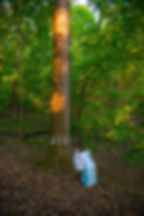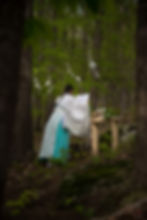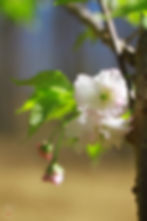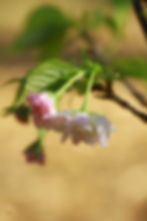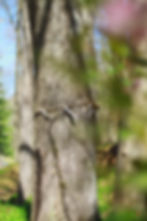
Japanese Earth Friendly studio by a Certified Kimono Consultant, Kimono Model/Photographer, Edo Tsumami Kanzashi Artisan, and Shinto Priestess.
神奈備万有乃杜(かむなび ばんゆうのもり)は、縄文時代まで遡る古神道の形態のままに、鎮守の森、磐境、磐座、御神木を、杜司(もりつかさ)の私有地にて御祀りし、大いなる自然の稜威に畏敬・畏怖・感謝の念を体現しております。
朝、鎮守の森の頂から差し昇る御来光は実に神々しく、遥拝時には雲間が晴れ、森を駆け巡る風や木々のさざめく音、舞い落ちる木の葉が応えて下さることもございます。苔生した磐座の青々とした息吹は年間を通し、冬でも枯れることがありません。夕焼けに染まる磐座や御神木は、息を飲む美しさです。満月の夜に輝く月明かりは祝詞を明るく照らして下さり、いつまでも佇んで居たい様な、凛とした優しさがあります。
この杜には、日本狼の血が色濃く残る有色紀州犬が神域への道案内に駆け回り、コイウルフ、狐、鹿、リス、鷲、鳶、カラス、ハミングバード、キツツキ、梟、そのほか様々な烏達、蛙、蛇、天道虫、蜻蛉など、様々な神使・野生動物が暮らしています。
私有地の神域につき一般参拝は受け付けておりませんが、積雪時を除き御予約制による個人様の御祈祷、神道講座や禊祓、神楽舞の内弟子に開放しております。
神奈備万有乃杜ではこの奥宮を以て、主に神籬式出張外祭を始め、禊祓、神楽奉納、神道講話などを斎行しております。どうぞ御気軽にお問い合わせ下さい。
【御由緒】
単立神社である大土山本宮(宗)天ノ岩座神宮・神職養成講座にて神社神道と古神道を修学し、平成27年(2015年)9月に神職資格を拝受した神職・金輪久仁子が、今の時代を生きる者のお役目として、先人たちが築いた日本文化の礎である古神道・神道の精神性を後世に繋げるため、普遍的な神々をお祀りしたことが由縁です。
海外で神明奉仕を積み重ねて参りました先に、普遍的な古神道の精神性・神奈備は万国共通・万有であるという結論を元に、その輪と和を世界に繋げたく、令和初年、今上陛下が大嘗祭を斎行なさいましたのち、謹んで命名させて頂きました。
(天ノ岩座神宮は神社本庁に属さない単立神社ですが、永代宮司の奈良泰秀先生は國學院大學を御卒業し神職資格を取得されておられますので、祭式作法や袴紐など、神職養成講座では國學院大學の方式を受け継いでおります)
神奈備:「神の隠れ籠れる場所」。自然環境そのものに神宿る神域、幽世(かくりよ)と現世(うつしよ)の端境・結界でもあり、禁足地も意味します。
万有:「宇宙に存在する全ての万物・万象」。世界中に存在する神奈備から、日本国外の方々にも古神道の精神性を身近に感じて頂けることを願って。
杜(もり):神を迎え祀る為の自然の聖域全体を指し、神そのものを象徴する語。神社、社(やしろ)ではなく、杜と命名した理由です。
万葉集「思はぬを思ふと言はば大野なる御笠の杜(もり)の神し知らさむ」(4-561)「千年に 欠くることなく 万代に あり通はむと 山科の 石田の杜(もり)の 皇神(すめがみ)に」(13-3236)
【御祭神】
天之御中主神:天地開闢において、宇宙の中心に最初に成り出でた神。造化三神・別天神の一柱。
高皇産霊尊:宇宙の生成・生産の神。幽界から顕界に分出しようとする霊の能きで、遠心力、拡散力。造化三神・別天神の一柱。
神皇産霊尊:宇宙の生成・生産の神。顕界から幽界に回帰する霊の能きで、求心力、凝縮力。造化三神・別天神の一柱。
天之常立神:天空の恒常的な確立の神。別天神の一柱。
国之常立神:大地の恒常的な確立の神。神代七代の一代。
天照大御神:高天原を治める太陽神。伊耶那岐神の禊祓にて左目より成り生まれた神。
月夜見尊:夜の世界を治める月の神。伊耶那岐神の禊祓にて右目より成り生まれた神。
大祓戸大神:祓を司る神々
メリーランド産土大神:アメリカ合衆国メリーランド州を守る神
大口真神:日本狼・山犬が神格化された神。山奥で道に迷った日本武尊を、霧のなか道案内した。
*そのほか八百万の神より、祭式毎に適した神を降神の儀にて降神賜ります
【神使】神奈備万有乃杜には色々な野生動物が暮らしています。
・日高系有色紀州犬
今は絶滅したと言われるニホンオオカミ(大口真神)が祖先の、紀州犬。優秀な狩猟犬である紀州犬は、その昔、熊野の山奥で峰弥九郎という猟師が助けたニホンオオカミが、その恩返しに届けた子狼《マン》の子孫です。民話として語り継がれ、『まんが日本昔ばなし』にもなっています。
紀州犬とは、広大な紀伊半島の山岳地帯にいた熊野犬、日高犬、那智犬、太地犬などの地犬達の総称。
白色を思い浮かべる方も多いと思いますが、元々は有色が多く、当杜の紀州犬も和歌山県美山村からの日高系で、オオカミの毛色配置が色濃く残っています。特に腰から差し尾にかけてその特徴が顕著に現れており、動きも犬というよりは実に野性味があり、正にオオカミの様です。
警戒心が非常に強く、地頭も良く、人の言葉を文章からも理解し、空気を読み、極めて勇敢で、家族を命がけで守護し、険しい森にあっても俊敏で、鹿や猪を相手に一歩も引かない強い気質を備えています。
杜を駆け回れば、御神気の素晴らしい神域を発見し案内をしてくれる神使です。大いなる自然の稜威の中に生きるという事を、体現してくれているようでもあります。
・蛙
・狐
時系列では稲荷信仰より遥か昔から、狐は日本中に生息していました。
民間信仰により狐は古来より神使として捉えられ、田の神を迎えるための斎場として祀られていた狐塚は、南は九州から北は秋田まで200以上あるようです。
民俗学者の柳田國男によりますと、初春に山から山の神が現れ田の神となり、秋の終わりには山に帰り山の神に戻るタイミングと、狐が村に現れては去るタイミングが合致していたとか。これらの狐塚はいずれ稲荷信仰から勧請を受け、神使である狐の概念と習合したと言われています。
当杜の狐たちは控えめながら、時に大胆に現れては杜を歩き回り、鳴き、たまに人間の物を山に持ち帰る愛くるしさがあります(杜司のクロックス、フォーム・マット、犬の玩具)。もふもふのしっぽが、とても印象的です。
・黒蛇(ブラック・ラット・スネイク)
蛇神は、土地の災難除けの守護神。
すい~、ぐん、すい~、ぐん、と進むその様は、正に龍のよう。蛇が高貴に神格化したものが龍、と言われる由縁です。
ブラック・ラット・スネイクは、害獣やその屍をお掃除してくれる良い蛇です。性格は穏やかで、つぶらな瞳がとても可愛い蛇です。毒は持っておりません。
静止していると黒いホースのようですが、進む際には実に美しい柄が白く浮かび上がります。
奇しくも丁度良く切り株に乗り、素晴らしい御姿を写真に撮らせてくれることもあります。
・ワタリガラス
・ハチドリ
アメリカ大陸ではハチドリは神の使いで、先住民の部族ごとに様々な神話があるようです。人前に姿を現す意味は共通して良い知らせで、人々に愛情や喜び、幸運を思い出させ、人助けをしてくれるとか。
1秒間に80回も羽ばたき、ヘリコプターの様に滞空飛行をしながら上下・後退飛びまでするのは、鳥の中でも実にハチドリだけだそうです。
苦戦しましたが、何とか良きシャッターチャンスに恵まれました。抹茶色が黄金に耀く神々しい姿、可愛らしいですね。
【杜司 もりつかさ】
宮司(ぐうじ・みやつかさ)は神社神道における神社の長・職階の敬称ですが、当杜は単立神社系統で社殿は無く神奈備を祀る杜(もり)ですので、杜司(もりつかさ)を敬称とさせて頂きます。
*******************************************************************************************************************************************************************************
KAMUNABI-BAN'YŪ-NO-MORI enshrines the beautiful sacred forest, mountain, rocks, and trees by the ancient Himorogi Ko-Shintō style of prehistoric Jōmon period. It dwells in a private propety of Rev. Kuniko Kanawa as Teinai-sha, to present respect, appreciation and awe to glorious virtue of Kami (deities) in great nature.
The sunrise peaks at the top of the sacred forest is truly awe-inspiring. When visiting, this Ko-Shintō shrine responds by clearing the clouds, gusting the wind in woods, merrily talking trees, and their dancing falling leaves. The lively energy of vivid green moss over the sacred rocks stay throughout the year and never wither. The sacred rocks and trees reflecting the sunset are breathtakingly beautiful. The graceful full moon light brightly shines Norito liturgy when reporting in the sacred forest at night.
Many kinds of beautiful animals live in this sacred site such as the descent of Japanese wolf Kishū dog run and guide visitors, coywolf (Eastern coyote), fox, deer, squirrel, crow, eagle, hawk, wood-pecker, owl, hummingbird, northern cardinal, non-poisonous snakes, frog, lady bug, dragonfly and so on.
This shrine is not open to the public as being Kinsoku-chi (tabood land) and the bounds of this sacred land, yet can be visited for a private ceremony/blessing by reservation and by Shintō class students, when not severely snowed.
Private visitors may enjoy a spiritual journey of a sacred pilgrimage through forest hike to various Himorogi sites.
Rev. Kanawa also travels to conduct Shintō ceremonies, Shintō lectures, Misogi-harae (water purification practice), workshop, and Kagura Shintō sacred dance. Please contact her for inquiries.
[ HISTORY ]
To preserve and pass the universal Ko-Shintō/Shintō spirituality to the future generations, Rev. Kuniko Kanawa studied Ko-Shintō/shrine shintō and humbly received the Shintō priestess certificate in September 2015 from Ama-no-iwakura-Jingū, the independent Ko-Shintō shrine in Hiroshima prefecture, Japan.
In the first Reiwa era after serving Himorogi style ceremonies for four years, she humbly received her clergy rank promotion, was approved to title Kamunabi Banyū Ko-Shintō Shrine and enshrine a number of universal nature Kami.
This is an independent Ko-Shintō shrine site, not the American branch of Ama-no-iwakura-Jingū. The major ceremonial decorum and Hakama sash tying follow Kokugakuin university style as her teacher Taishū Nara sensei, the head priest of Ama-no-iwakura-jingū graduated and licensed by Kokugakuin university.
Kamunabi: Sacred nature sites where Kami (deities) dwell. The barrier between Toko-yo (eternal spirit world) and Utsushi-yo (physical world). Tabooed land.
Ban'yū: All matters / phenomenons existing in the universe
Mori: Sacred nature area to invite Kami to descend. Symbolizes Kami itself.
(related poems can be found in Man'yōshū:Collection of Ten Thousand Leaves - Anthology of Japanese poetry)
[ ENSHRINED KAMI ]
Ama-no-minakanushi-no-kami : Deity emerged at the center of the universe
Takami-musuhi-no-kami : Deity of centrifugal force of the universe's generation/production
Kami-musuhi-no-kami: Deity of centripetal force of the universe's generation/production
Ame-no-tokotachi-no-kami : Deity of the sky constantly establishing
Kuni-no-tokotachi-no-kami : Deity of the Earth constantly establishing
Amaterasu-Oomikami : Sun deity
Tsukuyomi-no-mikoto : Moon deity
Oo-haraedo-no-Ookami : Great deities at the magnificent purification sites
Maryland Ubusuna-no-Ookami : Great guardian deity dwells in the state of Maryland
Ooguchi-Makami : Japanese wolf deity who once inhabited throughout Japan, guided the path for Yamato-takeru-no-mikoto in the deep mountain
* Other Kami can be called down temporarily by Kōshin-no-gi, depending on the ceremony
[ SHINSHI (DIVINE MESSENGER) ]
Introducing our special Shinshi divine messengers among many other wildlife in Kamunabi Ban'yū Ko-Shintō Shrine.
Kishū dog is well known as an excellent hunter in the forest, as they are the direct descendants of Japanese wolf known as Ooguchi-makami (Wolf Kami). Its history can be found in Japanese folklore.
One autumn in the Edo period, the boar hunter Yakurō Mine happened to find the wounded wolf in a deep mountain so he treated her. As she kept following him, Yakurō smiled and said goodbye by joking that she would one day give him one of her puppy wolves after she recovers well.
Following spring, after totally forgetting this event, he heard a puppy outside of his house. He found the wolf's puppy facing him right by the door. He figured it was the mother wolf repaying his kindness. She kept her promise.
This wolf puppy later became a great hunting buddy for Yakurō, the ancestor of Kishū dog. This folklore can be watched in this Anime.
The hunting master Kishū dogs are very cautious, naturally smart, understand human language, capture the atmosphere, remarkably brave, and protect family regardless of risking their lives, and swift even in steep mountains.
Modern day Kishū dogs are well known for being White color, however they are originally colored, just like wolf’s fur coloration, as seen in our Shinshi especially around her straight tail. Her motions are also rather wolf-like wind than a domesticated dog.
She has the greatest ability as a divine messenger to find and guide into sacred sites. She belongs to the forest. She shows how to live in great nature.
Frog
Black rat snake (non-venomous)
In Shintō, land snakes are perceived as a guardian Kami of the land. We encounter beautiful Black rat snake every spring. The one even climbs on the stump to give us beautiful poses for photography.
Raven
Hummingbirds are believed to be divine messengers in America by various Native American mythologies.
It is a good sign that they emerge in front of people, help reminding us love, joy, happiness.
Kitsune Fox also live in this sacred forest. To give you a deeper historical information based on the chronological order of Kitsune being existed prior to the cultivation of Japanese land and Inari faith, Kitsune actually have been always perceived as sacred divine messenger throughout Japan from Kyushu region to Akita prefecture, by the folk Shinto faith which built 狐塚 Kitsune-dzsuka ceremonial mound to Ta-no-kami, the Kami of the rice field. *塚:祭祀場として人工的に築かれた丘状の盛り土や積み石
According to Kunio Yanagita, one of the most accomplished Japanese folklorist, it was because of the timing of Yama-no-kami emerging from the mountain becoming Ta-no-kami, and Kitsune appearing to the villages was in accordance.
It is believed that these Kitsune-dzuka far later received Kanjō (transferring the divided spirit) of Inari faith, then became combined with the concept of Kitsune divine messenger.
民俗・習俗神道・民間信仰 Folk Shinto Faith is quite remarkable category, as they are native/indigenous which emerged from the local natural environment and people's lifestyle. Very down-to-Earth.
~ 参考文献 Reference List ~
『日本民俗大辞典』 (1999年)p. 468 吉川弘文館
福田アジオ:日本の歴史学者・民俗学者。国立歴史民俗博物館名誉教授、元・神奈川大学外国語学部・大学院歴史民俗資料学研究科教授。柳田國男研究者。柳田國男記念伊那民俗学研究所所長。
神田より子、新谷尚紀、中込睦子、湯川洋司、渡邊欣雄
『図説 民俗探訪事典』(1983)p.181-184 山川出版社
大島暁雄、佐藤良博、宮田登
『民俗の事典』(1972)「稲荷」p.292-293 岩崎美術社
大間知篤三・川端豊彦・瀬川清子・三谷栄一・大森志郎・大島建彦
『講座 日本の民俗宗教3』(1979)「田の神と稲荷」pp.196-200 弘文堂
直江廣治
[ MORI-TSUKASA ]
宮司 (Gūji/Miya-tsukasa) is a honorific for a chief priest at the shrine. Rev. Kanawa prefers "Mori-tsukasa" as her shrines is primitive sacred nature site with no shrine building.



























































































































